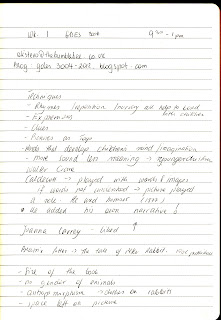One of my favourite illustrators is Kimberley Scott. She is a freelance illustrator of children's books, greeting cards as well as interested in calligraphy. I like her style which appeals to audience 5-10 of age. I find all of her illustrations colourful, lively, and children-like drawings. Her illustrations are a bit quirky. She uses a lot of patterns and lines: her drawings are outlined and slightly drawn out of line, which also reminds of children's drawings. Kimberley's illustration reminds me of Lauren Child, yet they are very subtle in design. My daughter loves her books and copies her drawings! :)
her blog is: http://kimberleyscottillustrates.blogspot.com/
Lately she published :
Princess Stories
Ballerinas Stories for Igloo Books
Cinderella Story, a Wheel-y Silly Fairy Tale
in it:
"..classic fairy tale Cinderella is retold with a silly twist in this playful, interactive format that's sure to keep little ones laughing. Readers can turn the wheel on each page of this paper-over-board title to choose the correct words needed to complete the scene and further the story. Once the "right" word is displayed, the art on the wheel completes the image. Silly options will entertain and guide readers to choose the correct word and image"
Super Sam written by 10 year old! for Collins Educational
Series of Little Bouncers books for younger audience for Small World Creation
Little Shakers series for Igloo Books

Her Greeting Cards:
In 2010 she created series of puzzles which went on sale in M&S:
Other Illustrators which inspire me are:
Lauren Child - English author and illustrator. Best known for: Charlie and Lola books: illustrations are filled full of everything from photographs to fabric scrap material. Her books are bold, as hesitant of her success as her characters, with their crimped mouths and vast, wary eyes, appear to be of their exuberant environments. Children Easy interact with those books as words are part of illustrations bend, twisted and upside-down. Font seems to be as child writing style.
Look at link below from guardian and see how it all started:
http://www.guardian.co.uk/books/2010/oct/04/lauren-child-clarice-children-books
such a creative ideas almost like collage!

Walter Crane (1845-1915): He believed that child imagination should be simulated.
"Children, like Egyptians, appear to see most things in profile, and like definite statements in design. They prefer well-defined forms and bright, frank colour. They don't want to bother about three dimensions. They can accept symbolic representations." (Illustrated Children's Books)
He was a fluent follower of the newer art movements and he came to study and appreciate the detailed senses of the Pre-Raphaelite Brotherhood, and was also a diligent student of the renowned artist and critic John Ruskin.
"The Brotherhood's early doctrines were expressed in four declarations:
- to have genuine ideas to express
- to study Nature attentively, so as to know how to express them
- to sympathise with what is direct and serious and heartfelt in previous art, to the exclusion of what is conventional and self-parodying and learned by rote
- most indispensable of all, to produce thoroughly good pictures and statues"
Illustration For The Frog Prince, 1874
 |
| Little Red Riding Hood Meets the Wolf in the Woods |


The Fairy Ship, 1870
It make she ponder that Crane did adopt these in his illustrations but saw them through CHILD EYE, which made them simplistic, natural portrayal of their world.
And this is what I believe, children do learn through seeing simple forms and what is fascinating they will adhere to simpler drawings rather than beautifully crafted, fine art illustrations. My idea of creating children's illustration is the one that is seen through child eyes - simplistic yet very memorable.
Jan Pienkowski: The bestselling Meg and Mog ( Baba Jaga) stories, first published in the 1970s and still a mainstay of British children’s literature today illustrated by Polish born Jan Pieńkowski. Pieńkowski came to live the UK in 1946 settling in Herefordshire. Design appears to have been in Pieńkowski’s blood as he comes from a family of artists and architects, and he showed a talent for poster and stage design when reading Classics and English at Cambridge.
This inspirational Polish migrant helped pioneer the modern children’s pop-up book and will be remembered for his cult illustrations in the fantastically titled classic Meg’s Eggs (witches and dinosaurs, what more can a child want?!). I enjoy Pieńkowski’s fabulous stories as a child and my children now read them again, and again and again today. To find out more about Pieńkowski’s work visit the Jan Pieńkowski website:
Meg and Mog also became characters of cartoons
He was a winner of the Kate Greenaway Medal for illustration (twice). Apart from book Haunted House, his pop-ups and the MEG & MOG series, created with Helen Nicoll, other work includes wonderfully evocative silhouette books such as Christmas and Easter, in the incomparable King James version. For the very young, he has written and illustrated the Nursery Books in bold and brilliant colours.
Pop-up Books:
Haunted House
He also created graphics:
Very interesting interview with jan Pienkowski about his life can be found:










































